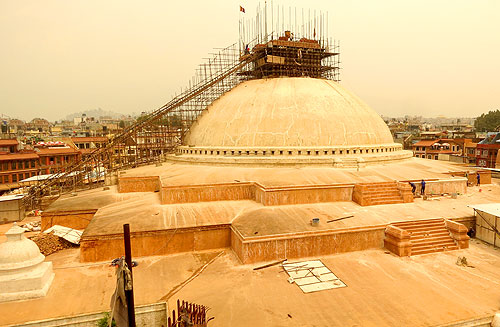 “Nepal’s resilience stems from its unique cultural heritage,” said Stefano De Caro, Director-General of ICCROM, as he honoured the memory of victims on the anniversary of the Gorkha earthquake which devastated a large part of the country on 25 April 2015, one year ago.
“Nepal’s resilience stems from its unique cultural heritage,” said Stefano De Caro, Director-General of ICCROM, as he honoured the memory of victims on the anniversary of the Gorkha earthquake which devastated a large part of the country on 25 April 2015, one year ago.
One month after the earthquake, ICCROM formed an international alliance of partners including ICOMOS-ICORP, ICOM, Smithsonian Institution and Prince Claus Fund to assist the Department of Archaeology and UNESCO Kathmandu Office in assessing damage and enhancing its capacity for stabilizing over 600 cultural sites and collections.
Earlier this year, ICCROM initiated a second set of activities aimed at recovery and risk reduction, joining forces with the Government of Nepal and its Department of Archaeology, Ritsumeikan University, Japan, and ICOMOS Nepal. This initiative was realized through the generous contributions of the Norwegian Ministry of Climate and Environment and UNESCO Kathmandu Office.
 Embracing the principles of sustainable recovery, the two hands-on workshops aimed at assisting in designing a shared vision and framework for the reconstruction of damaged cultural heritage sites and the rehousing of displaced cultural collections.
Embracing the principles of sustainable recovery, the two hands-on workshops aimed at assisting in designing a shared vision and framework for the reconstruction of damaged cultural heritage sites and the rehousing of displaced cultural collections.
Inaugurated by Mr Bhesh Narayan Dahal, the Director General of the Department of Archaeology, the first workshop on the recovery of cultural sites involved a range of national and international actors and agencies including the representatives of the Nepal Reconstruction Authority and the Municipality of Kathmandu. The aim was to promote coordination among various stakeholders and actors, and to evolve a shared vision for risk reduction and rehabilitation of cultural heritage sites and historical settlements. Over 50 architects, civil engineers, site managers and planners participated in the round tables and panel discussions held during the workshop.
 The second workshop focused on developing sustainable solutions for rehousing evacuated collections in safe and interactive spaces, with the goal of bringing greater numbers of visitors back to the museums. Twenty-seven professionals drawn from ten museums in Nepal participated in the second workshop. All of the participating museums face the twin challenges of rehousing displaced collections and boosting revenue by increasing the number of visitors. The workshop enabled the creation of a visible but secure storage space, where researchers and visitors can see objects in their respective housings and explore meanings through thoughtfully-prepared text panels and photographs (see video).
The second workshop focused on developing sustainable solutions for rehousing evacuated collections in safe and interactive spaces, with the goal of bringing greater numbers of visitors back to the museums. Twenty-seven professionals drawn from ten museums in Nepal participated in the second workshop. All of the participating museums face the twin challenges of rehousing displaced collections and boosting revenue by increasing the number of visitors. The workshop enabled the creation of a visible but secure storage space, where researchers and visitors can see objects in their respective housings and explore meanings through thoughtfully-prepared text panels and photographs (see video).
The Way forward
ICCROM’s engagement in Nepal has clearly shown that the recovery of cultural heritage is one of the main pathways for building a resilient society. However, the process of recovering heritage is complex and needs to be supported through collaboration, applied research and capacity development.
See also:
- UNESCO Stands by Nepal for Resilience and Inclusive Development
- First Aid to Nepal’s Cultural Heritage: from Recovery to Risk Reduction (ICCROM News, 15 June 2015)
- ICCROM forms an international alliance to assist in Nepal’s cultural recovery (ICCROM News, 5 June 2015)
- Nepal Cultural Emergency Report (ICCROM News, 20 May 2015)
- Disaster and risk management programme
[gallery royalslider="9" ids="14740,14738,14737,14735,14734,14733,14761,14760"]
